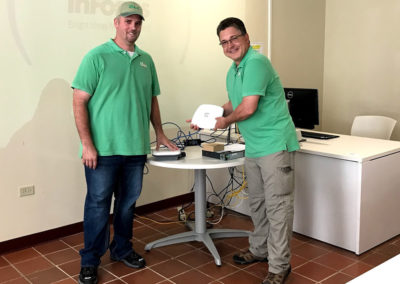Day 3: Establishing Wi-Fi-based Communications to Puerto Rico
This is our third daily log in our series on helping to establish communications leveraging our field solutions team and a generous donation of Wi-Fi equipment from Extreme Networks.
BEI Travel Journal: Day 3 In Puerto Rico
Staff from the Puerto Rico Science, Technology and Research Trust picked up the BEI team at our hotel early in the morning for the long drive to University of Puerto Rico Mayaguez. We traveled over the mountains and through some of the hardest hit areas.
The Mountain town of Cayey was hit by the eye of the hurricane and suffered major damage. Most trees on the island were stripped bare of all leaves—it’s very evident in this area with the large tree covered mountains—and is good to see green coming back. Small tufts of green leaves are appearing on the tops of trees which looked to me like the Truffula Trees from Dr. Seuss’s Lorax.
A member of the Trust staff remarked at the view and though he drove this road many times he never knew some of the sides of the mountains were covered with houses. The trees were previously so thick, they thought it was wilderness but there were entire neighborhoods hiding behind these formerly lush trees.
We continued over the mountains and emerged on the south side of the island, not too far from where Maria made landfall. The south side of the island is more arid and has fewer trees, so the natural devastation we’ve seen on the north and central part of the island is not as evident. However and unfortunately, the devastation to the infrastructure is. Nearly every power pole, street sign, and structure has visible damage. Most power poles throughout the island are leaning bent—or snapped together.

We continued through Ponce and Yauco, where much of Puerto Rico’s famous coffee is grown, and arrived at the University of Puerto Rico Mayaguez Campus. The BEI Team met with Martin Melendez, Director of Information Technology for the campus. After discussing the project with Martin, we proceeded to a large classroom where we trained his staff on deployment of the Extreme Networks Access Points and provided an overview of ExtremeCloud.
UPR Mayaguez is going to extend their network utilizing microwave point to point technology to deploy an Extreme Networks Access point to the town square of Mayaguez to provide Wi-Fi access to the community.
After the training session, the team from the Trust and BEI began the long journey back to San Juan—this time following the coast, traveling up the west and continuing along the northern edge of the island. We saw much of the same devastation to the foliage and power infrastructure you see everywhere on the island.
We also noticed many more small communities with houses that didn’t stand up well to the winds of Hurricane Maria. Many structures without walls and roofs were seen along the freeway. Due to the higher population density on this north side of the island, there were many more and larger power poles which were all damaged or destroyed.
Moving on, we continued past Rincon, Aguadilla, Arecibo (Home of the famous Telescope that miraculously survived the storm), and Dorado before entering the San Juan Metro area in the late evening. Evidence of the stress of the lack of power to the island is really obvious. The lack of street lights and traffic signals continues to cause havoc with the traffic. Major roads at 4 way intersections are a free-for-all and often end up in a tangled mess of cars.
The Importance of Communications to Recovery
It’s day 57 without power for Puerto Rico and the stress it has on the people is apparent. The long drive in the car gave us time to discuss the experiences of Hurricane Maria and the aftermath. We were really able to grasp how important power and communications are to the island. With power, citizens will have light, and more importantly, this will enable them to have water as well as it will power the water plants and pumps to deliver the water.

The discussion around these issues of communication validated our efforts here. There was a lot talk of the ports being loaded with supplies but that they could not get them delivered fast enough. One of the major issues is that the majority of truck drivers live in remote areas of the island and have zero communication capability. The transportation hubs were not able to get the word to them as to where they were needed or that they were needed at all.
This makes our mission that much more urgent, and it’s apparent to us that the people are truly appreciative that we are listening to them and helping.
View additional photos below and learn more from the field solutions team tomorrow.





